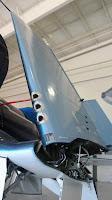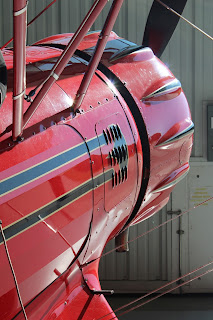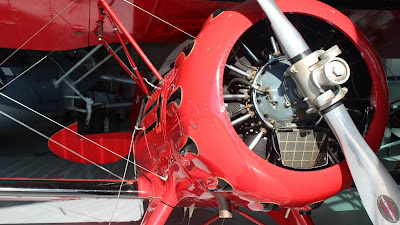I went to a safety seminar at an aviation event at the Suffolk Executive Airport and learned about the Military Aviation Museum. Had it gone that same weekend, I would have been able to see all of their biplanes fly. Bummer. I went the next weekend and it was still a good visit. This post has a lot of pictures but pictures of airplanes are kind of like pictures of landscapes or skies - they seldom capture the feeling of seeing it in person. And there were almost too many airplanes to capture.
Museum pamphlet (l), welcome sign (r) and map (below) on which I added the hangar locations.
At the west end of the field are several hangars - two of which hold WW I and WW II (German) aircraft. Obviously, the aircraft are impressive as all the biplanes are flyable, but I have to say the WW I hangar itself was beautiful. It's internal support is wooden and I think anyone would love to have a hangar like that.
WW II Hangar:
Bücker Bü 133C Jungmeister: This airplane is immaculate and just a cool, tough-looking biplane.
Engine detail of a Junkers Ju-52 (left) and the inlet of a Lippisch P.13a ramjet delta wing.
Focke-Wulf Fw 44: Another well-kept and operable biplane.
This FW-44, a "J" is the final model of what proved to be a very airworthy airplane.
WW I Hangar:
Albatros D.V: this is a cool plane...simple, tail 'wheel' is a stick, red bullet nose and a big gun.
Wooden propellers are amazing to me. They function exactly the same, but they're rare, and they always seem to be little works of art. The prop on this Fokker D.VII (left) is beautiful. On the right, is the Ely Curtiss Model D Pusher. This is a replica, but it is impressive. Impressive craftsmanship and impressive that it is completely functional.
Another beautiful propeller on a Blériot XI. I took the picture not only for the propeller, but for the graceful simplicity of the engine. This Anzani Three Cylinder engine knocked out a whopping 25 horsepower. The maximum speed is about 47 mph...10 slower than the rotation speed of a Cessna 172. I love that. The Bléroit XI debuted at the Paris Air Show in 1908, but became historic as it was the first airplane to cross the English Channel in July 1909.
You can get rides (pay for rides) in a 1941 Boeing Stearman (or Kaydet) or 1989 WACO YMF-5. Both are beautiful airplanes but these two shots are of their Stearman.
Army Hangar:
This is from the balcony of the Army Hangar...as you can see, a fantastic collection.
---
Ah...the P-40 Warhawk I love this plane but it always seems to take a back seat to the P-51 or P-47. Interestingly enough, it was the third most-produced American fighter (after those two) with a total of 13,738 being built. I think its lines are great and it wears the tiger mouth perfectly. This airplane is technically a "Kittyhawk". Warhawk, Tomahawk, and Kittyhawk were used for P-40s. For me, Tomahawk is acceptable, but I would never use Kittyhawk. Warhawks are US P-40s, while the Brits and Soviets used Tomahawk for theirs unless it was a P-40D or later; which are Kittyhawks.
A shot of the Flying Tiger and its sleekness looking forward.
Speaking of the P-47, how cool is this picture?
---
This 1934 Boeing P-26 Peashooter is visually stunning, but I imagine it's also a riot to fly. Aside from it's boisterous appearance, it was actually a leap in technology. It moved from fabric-covered wooden frames to all metal stressed skin, had a variable pitch propeller, and incorporated flaps.
---
This is the nose and cockpit of a MiG-3. I took it because it exudes brute force, but apparently it was a "cow" below 12000 feet and was quickly relegated to defensive units.
---
This De Havilland Tiger Moth must be a joy to fly. I should have taken a picture of the cockpit as it is perfectly simple. I also love the nose of this plane. Not your typical 'bullet' style, but I like how the radiator adds an almost artistic touch to the cowling.
---
This Polikarpov Po-2 "Mule" (also called the Sewing Machine due to its engine noise) is arguably, but likely, the most produced biplane ever. It's thought as many as 30000 were made. It was simple and reliable, which always contributes to being a Number 1.
---
Graceful lines...the nose of a Yakovlev Yak-3 and the tail of a Focke-Wulf Fw 190.
---
Odd addition, but cool enough is the iconic 1966 Amphicar.
Nice shot of a NAF N3N Canary (or Yellow Pearl). The prop and engine compliment
each other perfectly. You can't see it in this picture, but this Canary is on floats.
---
You would guess a Vought F4U Corsair (very iconic) but this is actually a FG-1D. I think I looked at this place for 10 minutes. Not so much for the aircraft but trying to imagine how the wings work. The engineering is incredible. These airplanes are immediately recognizable because of their gull wings. So why the gull wing? It's not to look cool (even though it does), it's to put the landing gear closer to the ground. This allowed a stronger strut but still giving clearance for the prop. Pretty cool.
---
Two noses of two famous workhorses...the T-34B Mentor (left) and the P-51 Mustang.
---

This, or the full version (below left), is probably my favorite picture of the day.
A 1989 WACO YMF-5 (mentioned above). I think I want to fly a YMF-5.
---
There was some good art inside the main building, but I couldn't find any details about the works.
This is a print, but I've always liked this painting and I'm certainly not alone
since I've seen it dozens of times. It is "Spitfire" by Barrie A. F. Clark.
Some nice oils of biplanes. These are no more than about 15" diagonal.
A cool depiction of an aerial battle and a nicely drawn portrait.
Couldn't resist.
If you're in the area, I certainly recommend a visit to this museum. If you can time it with a flying event, it would really make it a memorable experience.
- mm-













































No comments:
Post a Comment